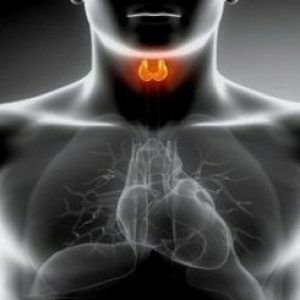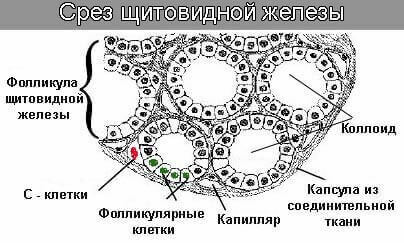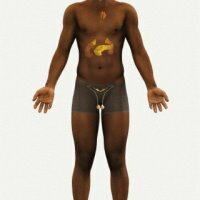Thyroid adenoma: types, tactics of treatment

Thyroid adenoma is a benign tumor( neoplasm) consisting of glandular cells.The adenoma can be of various sizes and has the property of being transformed into a malignant tumor.The most common pathology is manifested in people over the age of 40, while in women it occurs much more often.
The thyroid gland is part of the endocrine system and produces hormones that have certain properties.Adenoma can be diagnosed with a high degree of accuracy only during the cytological examination.
Table of contents: What is the thyroid gland Classification of thyroid adenoma Main causes of the onset of the disease Symptoms of thyroid adenoma Diagnosis The specific features of therapy for thyroid adenoma Recommendations after undergoing a course of treatment for thyroid adenoma Means of traditional medicine PreventionWhat is the thyroid gland
ThisThe body is characterized by a soft consistency and compact dimensions.It is located in the anterior and lateral parts of the larynx, adjacent to the thyroid cartilage.Good palpation with the head tilted forward.
The iron is horseshoe shaped, formed from two parts, connected by an isthmus.
Comprising:
- A-cells.They produce thyroxine and triiodothyronine and are considered to be the main ones.
- of B cells.Another name is the cells of Gurtle.Their main function is the production of bioactive substances.
- of C-cells.Control the production of a hormone responsible for the level of calcium.
The body performs various functions that allow the body to work in normal mode.
Among them:
- increase in the concentration of glucose in the blood;
- acceleration of metabolic processes, as well as energy production;
- normalization of the rhythm of contractions of the heart muscle;
- more frequent stools;
- cells become more sensitive to the effects of stress hormones;
- formation and destruction of red blood cells is accelerated.

The thyroid gland is regulated by the pituitary gland, which produces hormones that enhance its functions.The principle of interaction is as follows: with a decrease in the blood of triiodothyronine and thyroxine, pituitary hormone production is activated, and vice versa - when the level of thyroid hormones increases, the activity of the pituitary gland decreases.
An important condition for the normal production of hormones is the body's getting the iodine in the right amount.
Classification of thyroid adenoma
Several types of this adenoma are distinguished.Classification depends on the cells that make up the tumor.
Here are the main types:
- Toxic.Characterized by pronounced symptoms and the release of hormones in excess.
- Thyroid adenoma from B cells.
- Follicular tumor.Outwardly it looks like a node of round shape, covered with a capsule.

- Other types.
Of all types of adenomas of the thyroid gland, its symptomatology clearly differs only in its toxic form.Diagnosis of all the others is possible after laboratory studies of fragments of the tumor under a microscope.
In some cases, an adenoma may exhibit multiple sites.
The main causes of the disease
To date, the reasons for the emergence and development of this pathology have not been studied sufficiently.
Among the factors that affect the appearance of adenoma, doctors call:
- violation of the functions of the visceral nervous system;
- excessive pituitary activity;
- genetic factors;
- bad ecology;
- adverse conditions of work, study, life;
- intoxication;
- hormonal imbalance.
Note: toxic adenoma can develop from a non-toxic type.
Symptoms of thyroid adenoma
Most often such a tumor is discovered by chance.For example, during the medical examination of an endocrinologist.It is explained by the fact that the symptoms do not appear for a long time, since pathology can not be accompanied by excessive hormone production.
Symptoms typical for the initial stage:
- feelings of anxiety, increased irritability;
- weight loss;
- increased sweat secretion;
- rapid pulse;
- elevated temperature intolerance;
- uncharacteristic fatigue.
Symptoms of adenoma of the thyroid gland that is significant:
- pain in the throat;
- neck shape changes;
- the tumor becomes noticeable visually;
- cough;
- the voice changes;
- shortness of breath.
Symptoms indicating a toxic pathology type:
-
 increased sweating and fatigue
increased sweating and fatigue - heart palpitations;
- frequent stools;
- vision impairment;
- dry eyes and their protrusion;
- visual bifurcation of objects;
- muscle weakness;
- increased nervous excitability;
- uncontrolled fears;
- sleep disorders;
- accelerated speech;
- excessive irritability, excitability;Atrial fibrillation;
- atrial fibrillation;
- increased blood pressure;
- painful attacks in the abdomen;
- total loss or vice versa, increased appetite;
- violation of coordination of movements;
- sensations of lack of air;
- shortness of breath;
- deterioration of potency;
- breast increases in size;
- infertility;
- change in the periodicity of menstruation, which can be accompanied by headaches, general decline of strength, pain;
- increases the amount of urine;
- increases blood glucose levels;
- strong thirst;
- premature appearance of gray hair.
View full list »
Important : severity of symptoms, as well as a set of symptoms indicative of toxic thyroid adenoma, depends on the length of the node, its activity and size.
Diagnosis
The pathology not diagnosed yet can be diagnosed by a doctor specializing in endocrine system diseases.Further differentiation of the tumor is carried out using additional methods of research.
inspection endocrinologist
important : all, without exception, people are advised to be inspected by an endocrinologist prophylactically at least once in 12 months.First of all, it concerns women.This approach is an important condition for the early detection of pathology and its successful treatment.
The patient is examined in several stages:
- Anamnesis history.The doctor finds out what disturbs the person, what symptoms are observed, when for the first time some signs and character of the disease development were noticed, reveals the factors that could affect its development.
- Visual inspection of the neck.If the site is of considerable size, then this is clearly visible.
- Palpation of the thyroid gland.
These methods allow you to determine only the presence of a node and the presence of increased functionality of the gland.
To obtain more complete and accurate information apply various types of instrumental diagnostics:
-
-

- puncture biopsy( cytological examination),
- radioisotope scanning,
- various kinds of tomography( MRI, CT),
- hormone level( thyroid and thyrotropic) studies,
- biochemical blood test.
In some atypical cases, referrals for additional examinations may be prescribed.
Features of therapy for thyroid adenoma
For the treatment of thyroid tumors, drug therapy and surgery are used.Conservative treatment of this disease is very poor.
Medical therapy is prescribed in the following cases:
- Preoperative preparation for thyrotoxic adenoma.It is due to the fact that the operation to remove the tumor is carried out when the amount of hormones in the blood is normal( the state of euthyroidism).Therefore, before the operation, a course of treatment is prescribed.The main goal is the normalization of thyroid hormone production.
- Colloid adenoma of the thyroid gland.In particular, during pregnancy.
The most effective way to treat this pathology is to remove the tumor with the surgical method.Thus, it is possible to achieve almost 100% of the result.But there are a number of contraindications, when the operation can not be carried out, for example, old age.
In such a case, the following methods are used:
- taking preparations containing radioactive iodine, which, accumulating in the thyroid gland, irradiates it, suppressing the function and destroying the cells of the neoplasm;
- is an injectable injection into an ethanol unit that cauterizes tumor cells, and as a result they die.
Specialists recommend people who have been diagnosed with this disease during a pre-operative period to lead a healthy lifestyle, avoid stressful situations, establish a balanced diet, provide full sleep, take prescribed phytopreparations, and refrain from visiting the solarium and staying in direct sunlight for a long time.
After effective treatment, specialists insist:
- regularly undergo a preventive examination by an endocrinologist;
- to abstain from alcohol, smoking, overeating;
- does not stay in the sun for a long time;The
- daily menu should be balanced and complete;
- periodically check the blood levels of thyroid hormones.
Traditional medicine
The doctor prescribes phytotherapy for the treatment of thyroid adenoma.Usually this occurs during the preparation for the operation.The main goal is the suppression of thyroid function.
For this, the following plants are most commonly used:
- zheruha medicinal;
- Icelandic cetrarium;
- a dyke dyeing.
The following plants are characterized by the content of an analogue of the hormone produced by the thyroid gland.But it does not affect the body, but only the pituitary gland, suppressing its function.
These include:
- black grass common;
- is a common bruise;
- bovine ordinary;Comfrey comfy
- ;
- red-breasted chasseur.
Important: all of the above phytopreparations may only be used as prescribed by your doctor.
It should also be understood that no traditional medicine will provide full recovery.Phytopreparations can be prescribed as an additional remedy for medical treatment or during the preparation for surgery.Do not self-medicate.
Prevention
Prophylaxis of thyroid adenoma is the observance of several simple rules.
- Maintain a healthy lifestyle.
- Every year, undergo a check-up at an endocrinologist.First of all it concerns women.
- Check the level of hormones in the blood.
- Give blood( at least once every 12 months) to biochemical analysis.
This will help you avoid relapse and immediately take adequate measures if there are any complications.
Natalia Tavaluk, medical reviewer
-



